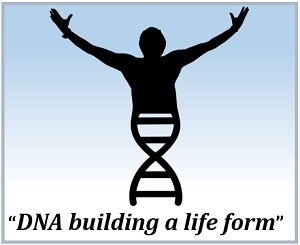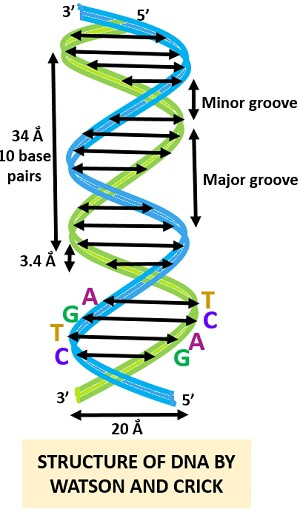Watson and Crick model of DNA provides one of the best ways to demonstrate the structure of double-helix DNA. A DNA is a polymer composed by the combination of several monomer units (deoxyribonucleotides) linked by the phosphodiester bond. In the discovery of DNA, many scientists have contextualized the structure of DNA, its components and composition etc.
Watson and Crick’s demonstrated a model, which explains all the physical and chemical features of the DNA. Before Watson and Crick, Friedrick Miescher, P. A. Levene, W.T. Astbury, Maurice Wilkins and Rosalind Franklin were the scientists who helped Watson and Crick to further study the DNA structure.
Watson and Crick’s model is the most successful model of DNA for which they have won the Noble Price in Physiology and Medicine in 1962 which they shared with Maurice Wilkins, but not with the Rosalind Franklin due to her unfortunate death in 1958.
Content: Watson and Crick Model of DNA
History of DNA Double Helical Structure
In the year 1869
A Swiss physiological chemist “Freidrich Miescher” identified something in the nuclei of the WBCs, which he termed it as “Nuclein”. Today, the term nuclein refers to a nucleic acid such as deoxyribonucleic acid.
In the year 1920
Phoebus Aaron Theodore Levene (an American organic chemist) discovered the elemental composition of nucleic acid. He explained one approach which is universally known as “Tetranucleotide hypothesis” according to which the base composition of all the four nitrogenous bases, i.e. A, T, G and C will be same.
In the year 1940
An English physicist and Molecular biologist, William Thomas Astbury gave the three dimensional model of DNA through X-ray crystallography.
In the year 1950
An Austro-Hungarian biochemist, Erwin Chargaff has demonstrated the “Biochemistry of DNA” by giving two approaches. Firstly, the sum of purines and the sum of pyrimidines will be equal in the DNA. Secondly, Erwin Chargaff concluded that the DNA composition varies between the different species. These two postulates commonly refer to the “Chargaff’s Rule”.
In the year 1952
Maurice Wilkins, Rosalind Franklin and co-workers introduced the photographs of the DNA by the method of “X-ray Diffraction”. R. Franklin has introduced the super X-ray diffraction photograph of DNA.
In the year 1953
Two scientists, James Watson (an American molecular biologist, geneticist and zoologist) along with Francis Crick (a British molecular biologist, biophysicist and neurologist) have demonstrated the double-helical structure of DNA. James Watson and Francis Crick collaborated with the Maurice Wilkins and Rosalind Franklin to introduce the DNA model. The model explained by Watson and Crick is considered to be the best model. Watson and Crick gain a lot of attention and appreciation for their work in the discovery of the DNA double-helical structure. They won Nobel Prize for their contribution in the year 1962 which they shared with the Wilkins.
| Year | Discoverer | Discovery |
|---|---|---|
| 1869 | Freidrich Miescher | Discovered “Nuclein” a nucleic acid the nuclei of human WBCs |
| 1920 | P.A. Levene | Introduced basic composition of “Nucleic acid” |
| 1940 | W.T. Astbury | Discovered 3D-model of DNA by X-ray Crystallography |
| 1950 | Erwin Chargaff | Introduced two postulates where A+G=T+C and the variance of the DNA base sequence between different species |
| 1952 | M. Wilkins, R. Franklin and co-workers | Discovered the photographs of DNA through “X-ray diffraction” |
| 1953 | Watson and Crick | Discovered the double helical structure of DNA by the study of X-ray diffraction photographs given by Wilkins and R. Franklin |
Video: Watson and Crick Model of DNA
Structure of DNA by Watson and Crick
Watson and Crick displayed the structure of DNA after studying the manuscript of the two scientists Linus Pauling and Corey. In 1953, Linus Pauling and Corey gave the 3D-structure of nucleic acid, which was not successful. Then, (in early 1953) Watson and Crick together combined the data of physical and chemical properties and proposed a double-helical structure of DNA. The main characteristics of Watson and Crick model of DNA include:
Physical Properties of DNA
- According to the Watson and Crick model, the DNA is a double-stranded helix, which consists of two polynucleotide chains. The two polynucleotide chain are spirally or helically twisted, which gives it a twisted ladder-like look.
- Both the polynucleotide strands of DNA have the opposite polarities, which mean that the two strands will run in the antiparallel direction, i.e. one in 5’-3’ and other in 3’-5’ direction.
- The diameter of ds-stranded DNA helix is 20Å.
- The distance between the two nucleotides or internuclear distance is 3.4Å. The length of DNA helix is 34Å after a full turn and it possesses 10 base pairs per turn.
- The DNA is twisted in “Right-handed direction” or we can say in a “Clockwise direction”.
- Turning of DNA causes a formation of wide indentations, i.e. “Major groove”. The distance between the two strands forms a narrow indentation, i.e. “Minor groove”. The formation of major and minor grooves result after the DNA coiling and the grooves also act as a site of DNA binding proteins.
Chemical Properties of DNA
- There are four nucleotide bases present in the polynucleotide chain like adenine, guanine, cytosine and thymine. Adenine and guanine are the two purine bases, which have a single ring structure. Cytosine and thymine are the two pyrimidine bases, which have the double-ring structure.
- The two strands are joined together by the “Complementary base pairing” of the nitrogenous bases. Therefore, a purine base will complementarily pair with the pyrimidine base, in which ‘Adenine’ pairs with ‘Thymine’ and ‘Guanine’ pairs with ‘Cytosine’.
- The nucleotide bases in the polynucleotide strands of DNA will join with each other through a strong hydrogen bond.
- Adenine complementarily pairs with thymine through two hydrogen bonds, whereas guanine complementarily pairs with cytosine by means of three hydrogen bonds.
- The nucleotide base composition of DNA follows the Chargaff’s rule where the sum of purines is equal to the number of pyrimidines. The base composition of A + G = T + C obeys the Chargaff’s rule, but the base composition of A + T is not equal to the G + C.
- Polynucleotide strands of DNA consist of three major components, namely nitrogenous bases, deoxyribose sugar and a phosphate group.
- The backbone of DNA consists of the sugar-phosphate backbone. The sugar-phosphate backbone holds both the polynucleotide strands of DNA by means of “Phosphodiester bond”. Therefore, the bonding between sugar and phosphates, i.e. phosphodiester bond and the bonding between nitrogenous bases, i.e. hydrogen bond contributes to the “DNA Stability”.
Conclusion
The DNA is a supermodel proposed by Watson and Crick in the year 1953. The discovery of double helix DNA was not possible without the collaboration of Maurice Wilkins and Rosalind Franklin. Maurice Wilkins and Rosalind Franklin discovered the picture of DNA through X-ray crystallography. The X-ray diffraction picture of DNA helped Watson and Crick to further study the DNA structure and components. By this, Watson and Crick proposed a model for DNA known as Watson and Crick’s model of double-helical DNA.

The DNA is the largest biomolecule which contains all the genetic information of the person to build an organism or a life form. The study of DNA double-helical structure helps us to know about the chemical and physical properties of DNA, apart from the property of DNA being a “Genetic material”.

Thank you very much. It is so helpful for me.
Thank you in advance for the post. Its really made my assignment much easier.